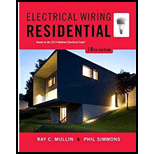
Electrical Wiring: Residental - With Plans (Paperback) Package
18th Edition
ISBN: 9781305416376
Author: MULLIN
Publisher: Cengage
expand_more
expand_more
format_list_bulleted
Concept explainers
Question
Chapter 19.1, Problem 4R
To determine
State what is used to move the impeller wheel.
Expert Solution & Answer
Want to see the full answer?
Check out a sample textbook solution
Students have asked these similar questions
Solve and select the correct answer:
2. For a random variable X with pdf: p(x)
value of x is
=
119
10
for -5≤x≤5. The mean
(a) -75
(b) 10
(c) 0
(d) 75
3. Is the matrix A = = [1] orthogonal? Find the rank of A?
0
(a) YES, -1
(b) NO, 2
(c) YES, 2
(d) NO, -1
4. L{et sin(3t)u(t)) = (a)
s-3
(s-2)²+9
2
(b)
(5-3)² (c)
(s-3)²+4
S-2
3
(s-2)²+9
(d) (5-2)²+9
=
5. Given that x is a constant. Choose all the correct solutions for [∞ (AB)] =
(a) (AB)T (b) x ATBT
(c) α BTAT
(d) x (AB)T
DO NOT WANT AI WILL REJECT
3. Roughly sketch the root locus for the following locations of open-loop poles and
zeros. You just need to show the shape of the root locus; you do not calculate the
asymptote, break-in, and break-away points.
☑
(a)
(b)
☑
Φ
①
$3
(c)
Chapter 19 Solutions
Electrical Wiring: Residental - With Plans (Paperback) Package
Ch. 19.1 - Does a jet pump have any electrical moving parts...Ch. 19.1 - Prob. 2RCh. 19.1 - Where is the jet of the pump located?...Ch. 19.1 - Prob. 4RCh. 19.1 - Prob. 5RCh. 19.1 - Prob. 6RCh. 19.1 - Prob. 7RCh. 19.1 - What is compressed in the water storage tank?...Ch. 19.1 - Explain the difference between a 2-wire...Ch. 19.1 - Prob. 10R
Ch. 19.1 - Why is a 240-volt motor preferable to a 120-volt...Ch. 19.1 - How many amperes does a 1-horsepower, 240-volt,...Ch. 19.1 - What size are the conductors used for this branch...Ch. 19.1 - Prob. 14RCh. 19.1 - What provides the running overload protection for...Ch. 19.1 - What is the maximum ampere setting permitted for...Ch. 19.1 - Prob. 17RCh. 19.1 - Because the controller contains the motor starting...Ch. 19.1 - Prob. 19RCh. 19.1 - Proper pressure of the submersible pump system is...Ch. 19.1 - Fill in the data for a 16-ampere electric motor,...Ch. 19.1 - The NEC is very specific in its requirement that...Ch. 19.1 - Does the NEC allow submersible pump cable to be...Ch. 19.1 - Must the disconnect switch for a submersible pump...Ch. 19.1 - A metal well casing (shall) (shall not) be bonded...Ch. 19.2 - Prob. 1RCh. 19.2 - A major hazard involved with water heaters is that...Ch. 19.2 - Prob. 3RCh. 19.2 - The heating elements in electric water heaters are...Ch. 19.2 - An 80-gallon electric water heater is energized...Ch. 19.2 - Prob. 6RCh. 19.2 - For residential water heaters, the Consumer...Ch. 19.2 - An 80-gallon electric water heater has 60F...Ch. 19.2 - Approximately how long would it take to produce...Ch. 19.2 - Two thermostats are generally used in an electric...Ch. 19.2 - a. How many heating elements are provided in the...Ch. 19.2 - When does the lower heating element operate?...Ch. 19.2 - Prob. 14RCh. 19.2 - Prob. 15RCh. 19.2 - Prob. 16RCh. 19.2 - a. If both elements of the water heater in this...Ch. 19.2 - a. How much power in watts would the two elements...Ch. 19.2 - A condominium owner complains of not getting...Ch. 19.2 - For a single, nonmotor-operated electrical...Ch. 19.2 - A 7000-watt resistance-type heating appliance is...Ch. 19.2 - Prob. 22R
Knowledge Booster
Learn more about
Need a deep-dive on the concept behind this application? Look no further. Learn more about this topic, electrical-engineering and related others by exploring similar questions and additional content below.Similar questions
- DO NOT NEED AI WILL REJECTarrow_forward5. Sketch the root locus for L(s) = s+10 using rules 1, 2, and 4. For rule 4, you need to s(s+6) find the break-in and break-away points.arrow_forwardS+4 4. Sketch the root locus for L(s) = (s+6) (s+1)2 using rules 1, 2, and 3. For rule 3, you need to find the value of σ and a for the asymptotes. From the root-locus, explain why the closed-loop system is always stable for any choice of the design parameter K in the range 0 < K < ∞o.arrow_forward
- 2. Consider the following system. K(s+3) (s+4) (s+1)(s+2) Check whether the points below are in the root locus. If the point is in the root locus, then also find what the corresponding gain K. i) ii) -2+j3 -2+1√ √ Hint: First find L(s). Next, in L(s) replace s with the value of the point and then express it in polar format r20 using calculator. The point will be in the root locus if and only if = 180° or odd multiple of 180°. When the point is in the root locus, the corresponding gain K is obtained as K ==arrow_forwardsolve and show workarrow_forwardDesign and find values. please solve ASAP (it's for practice before an exma, I don't have time)arrow_forward
- Can you show why the answer is that for this question using second order differential equations, instead of laplace transformsarrow_forward2. For each of the following transfer functions, G(s) = Y(s)/U(s), find the differential equation relating the input u(t) to the output y(t). (s+2)(s+3) (a) G(s) = (s+1)(s+4) (s²+0.4s+1.04) (s+3) (b) G(s)= (s2+0.2s+1)(s+2)(s+4)arrow_forwardDon't use ai to answer I will report you answerarrow_forward
arrow_back_ios
SEE MORE QUESTIONS
arrow_forward_ios
Recommended textbooks for you
 EBK ELECTRICAL WIRING RESIDENTIALElectrical EngineeringISBN:9781337516549Author:SimmonsPublisher:CENGAGE LEARNING - CONSIGNMENT
EBK ELECTRICAL WIRING RESIDENTIALElectrical EngineeringISBN:9781337516549Author:SimmonsPublisher:CENGAGE LEARNING - CONSIGNMENT

EBK ELECTRICAL WIRING RESIDENTIAL
Electrical Engineering
ISBN:9781337516549
Author:Simmons
Publisher:CENGAGE LEARNING - CONSIGNMENT